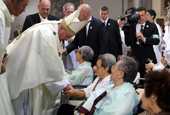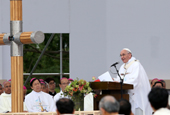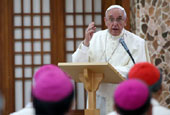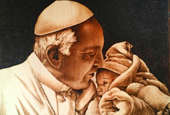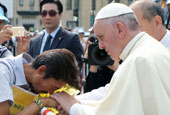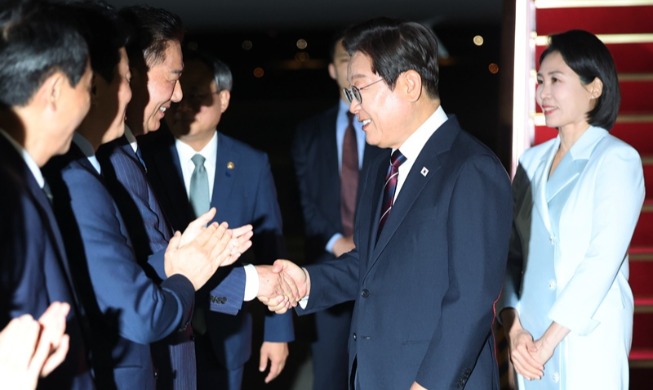The pope's recent visit to Korea, the first nation in the Asian region, has brought with it the global limelight from a number of media outlets. There has been widespread coverage on the meaning behind the visit and on every step the pope took in Korea.
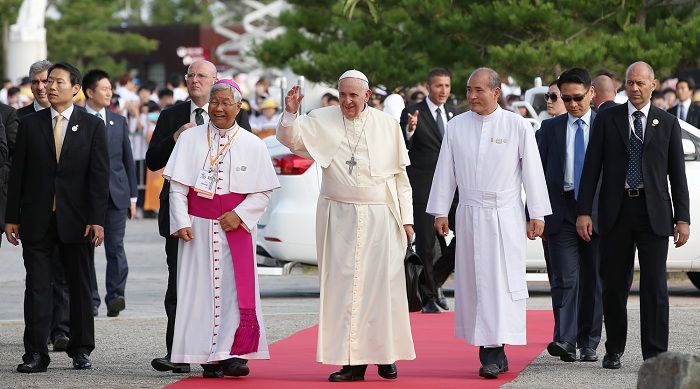
A number of influential media outlets -- including the BBC, AFP and WSJ -- calculated that the number of Korean Catholics stands at 5.4 million, only three percent of the worldwide total. Korean faith, however, is increasing with growing speed, while other countries including Europe and the U.S. show signs of slowing.
Some other media outlets, such as AP and Bloomberg, put the pope's Korean visit, ahead of a trip to the Philippines, down to the history of Korean Catholics.
Bloomberg reported that, "The scene in a Buddhist-majority nation that once tortured thousands of Christians to death helps explain why Pope Francis chose South Korea for the first papal visit to Asia in 15 years."
Meanwhile, the Vatican stressed that, first of all, the pope's visit to Korea was mostly related to attending the Asian Youth Day event in Daejeon on August 15, which is one of the biggest Catholic festivals. They also explained that Korea, along with its neighbor China, has the power to expand the congregation further, and emphasized that, "The trip is to Korea, but the real destination is all the countries on the continent."
In addition, the pope's journey through Chinese airspace aroused diverse interpretations. The BBC and South China Morning Post showed an interest in the possibility of a new relationship between the Vatican and the Chinese government that has been frozen since 1949.
Reuters quoted Father Bernardo Cevellera, head of the Rome-based Asia News agency and a specialist on the Catholic Church in China, who said "This is a sign of detente, for sure, but the real miracle would be if (Chinese President) Xi Jinping responds with his own telegram, and what he says."
The Global Times, based in China, conducted an interview with a professor of Social Studies in Zhejiang. The scholar was quoted as saying that the pope's visit to Korea seems to demonstrate a support for Catholic believers in China and Russia, and at the same time, to deliver a certain message to the two governments of the region.
A number of media outlets including AP, CNN and BBC covered via live broadcast every step the pope took -- the beatification ceremony for the martyrs at Gwanghwamun Square, visits to holy sites as well as the closing Mass of the sixth Asian Youth Day.
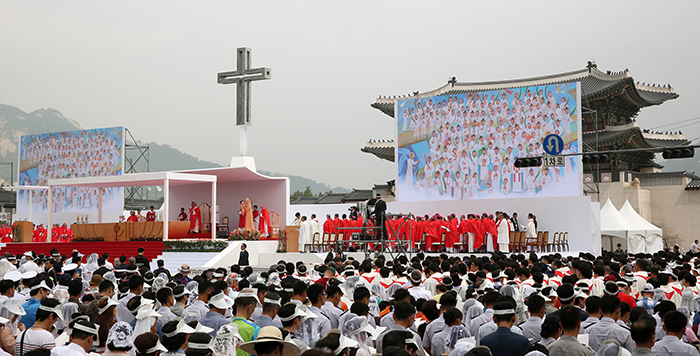
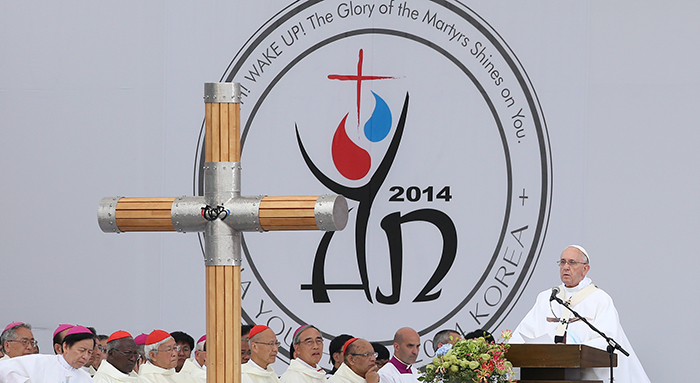
Meanwhile, some outlets turned the spotlight towards the recent tragic sinking of the Sewol ferry, as well as the crisis of the middle-class, as influenced by the nation's economic development. Le Monde and Reuters described the country as "a nation still in shock," and "where, alongside immense wealth, dire poverty is silently growing" respectively, making comparisons with 30 years ago when Pope John Paul II visited.
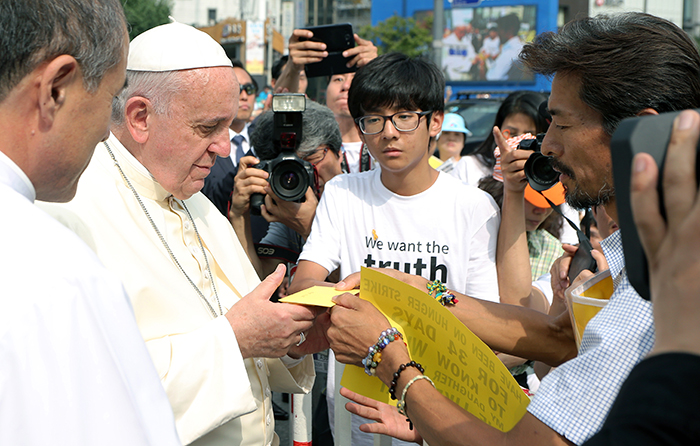
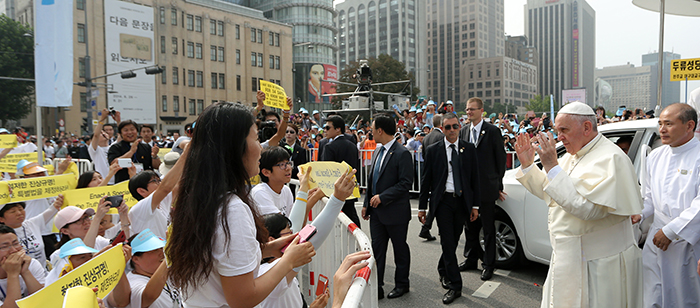
The August 15 edition of the New York Times gave spotlight to the efforts of Pope Francis in sharing the wounds and despair of the people in Korea. In an article titled "Pontiff Voices Hope for Korean Peace and Grief for Ferry Victims," the newspaper reported that "Francis impressed many South Koreans with his humble touch when he chose to ride to the Vatican Embassy in a Kia Soul hatchback, one of the smallest cars in the country." The U.S. daily also quoted some Twitter accounts of South Korean citizens who tweeted "The pope rode in a Soul because he is full of soul. Soul Soul Seoul!" and "A real leader not only because he rejected pomposity and vanity but also because he showed concern about global warming." The New York Times added that, "At a brief welcoming ceremony at the airport, the pope met with the father of an 18-year-old student who died in the ferry sinking, and with three other people who lost family members," while quoting the pope himself, "My heart aches for you. I remember the victims."
The Mass for peace and reconciliation held at the Myeongdong Cathedral was also one of the main topics of interest for foreign correspondents. The media coverage ranged from discussing the North Korean Catholics invited to the Mass, to the elderly women forced to work as sexual slaves for the Japanese military during World War II.
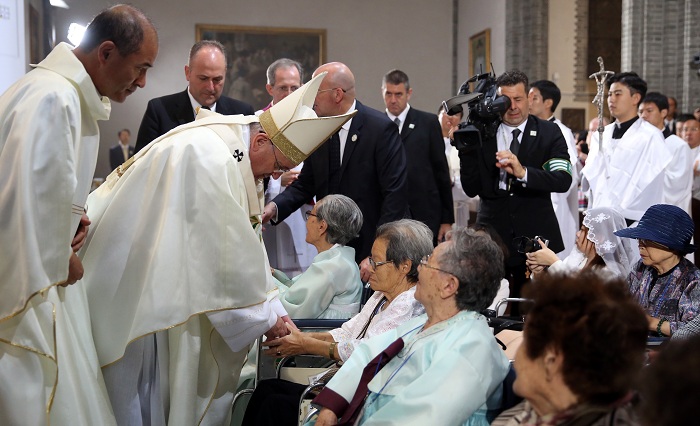
In regards to the short-range missiles fired by North Korea on the day the pope arrived in Korea, some U.S. based newspapers published articles about how Pope Francis called for the reconciliation of the two Koreas. CNN published a piece titled "Pope Francis Calls for Reconciliation between Two Koreas in First Asia Visit," while a UCA News article was titled "Pope Francis to pray for North Korea's 'church of silence."
Le Figaro suggested that, through his words and behavior, Pope Francis strives to reignite the light on the reunification of the Korean peninsula that has slowly faded away from generation to generation.
Most of the Japanese media outlets gave the spotlight to the final Mass for peace and reconciliation held on August 18 at the Myeongdong Cathedral in Seoul, paying sharp attention to Pope Francis mentioning the sensitive issues about the comfort women.
Pope Francis began his five-day schedule on August 14 at Seoul Airport where he was greeted by President Park Geun-hye, and finished at the Mass for peace and reconciliation at the Myeongdong Cathedral on August 18.
The online Wall Street Journal said that Pope Francis impressed Korean people with his humble attitude and the showing of his true self during his journey.
The August 19 edition of the Washington Post hinted at the prospects for a possible exchange between the Vatican and China, quoting Lionel M. Jensen, associate professor of East Asian Languages and Cultures at the University of Notre Dame, who said China is beginning to recognize Francis as a "force of universal peace and human sanctity."
The newspaper also quoted Romano Prodi, a former Italian prime minister, who told the Italian daily, Corriere Della Sera, "China does not see him as a representative of Western interests or of having a Eurocentric mindset," to highlight the reaching out of the pope's hands first towards China.
The article concluded with Professor Jensen saying, "For the future growth of Catholicism in Asia, the pope's visit will act as an accelerant. The effects of his time in Korea should be understood like ripples across a pond from a pebble's drop. The reach will be considerable, and it is clear that this is an effect he is seeking."
By Lee Jeong-rok, Lee Seung-ah
Photographed by Jeon Han
Korea.net Staff Writers
Jeongrok@korea.kr

Pope Francis visited Solmoe Sanctuary in Dangjin, South Chungcheong Province on August 15.
A number of influential media outlets -- including the BBC, AFP and WSJ -- calculated that the number of Korean Catholics stands at 5.4 million, only three percent of the worldwide total. Korean faith, however, is increasing with growing speed, while other countries including Europe and the U.S. show signs of slowing.
Some other media outlets, such as AP and Bloomberg, put the pope's Korean visit, ahead of a trip to the Philippines, down to the history of Korean Catholics.
Bloomberg reported that, "The scene in a Buddhist-majority nation that once tortured thousands of Christians to death helps explain why Pope Francis chose South Korea for the first papal visit to Asia in 15 years."
Meanwhile, the Vatican stressed that, first of all, the pope's visit to Korea was mostly related to attending the Asian Youth Day event in Daejeon on August 15, which is one of the biggest Catholic festivals. They also explained that Korea, along with its neighbor China, has the power to expand the congregation further, and emphasized that, "The trip is to Korea, but the real destination is all the countries on the continent."
In addition, the pope's journey through Chinese airspace aroused diverse interpretations. The BBC and South China Morning Post showed an interest in the possibility of a new relationship between the Vatican and the Chinese government that has been frozen since 1949.
Reuters quoted Father Bernardo Cevellera, head of the Rome-based Asia News agency and a specialist on the Catholic Church in China, who said "This is a sign of detente, for sure, but the real miracle would be if (Chinese President) Xi Jinping responds with his own telegram, and what he says."
The Global Times, based in China, conducted an interview with a professor of Social Studies in Zhejiang. The scholar was quoted as saying that the pope's visit to Korea seems to demonstrate a support for Catholic believers in China and Russia, and at the same time, to deliver a certain message to the two governments of the region.
A number of media outlets including AP, CNN and BBC covered via live broadcast every step the pope took -- the beatification ceremony for the martyrs at Gwanghwamun Square, visits to holy sites as well as the closing Mass of the sixth Asian Youth Day.

The beatification ceremony for the 124 martyrs took place on August 16 at Gwanghwamun Square in central Seoul.

Pope Francis celebrates the closing Mass of the sixth Asian Youth Day at Haemi Fortress in South Chungcheong Province on August 17.
Meanwhile, some outlets turned the spotlight towards the recent tragic sinking of the Sewol ferry, as well as the crisis of the middle-class, as influenced by the nation's economic development. Le Monde and Reuters described the country as "a nation still in shock," and "where, alongside immense wealth, dire poverty is silently growing" respectively, making comparisons with 30 years ago when Pope John Paul II visited.


Pope Francis passes along words of comfort on August 16 for the bereaved families who lost their loved ones in the tragic sinking of the Sewol ferry.
The August 15 edition of the New York Times gave spotlight to the efforts of Pope Francis in sharing the wounds and despair of the people in Korea. In an article titled "Pontiff Voices Hope for Korean Peace and Grief for Ferry Victims," the newspaper reported that "Francis impressed many South Koreans with his humble touch when he chose to ride to the Vatican Embassy in a Kia Soul hatchback, one of the smallest cars in the country." The U.S. daily also quoted some Twitter accounts of South Korean citizens who tweeted "The pope rode in a Soul because he is full of soul. Soul Soul Seoul!" and "A real leader not only because he rejected pomposity and vanity but also because he showed concern about global warming." The New York Times added that, "At a brief welcoming ceremony at the airport, the pope met with the father of an 18-year-old student who died in the ferry sinking, and with three other people who lost family members," while quoting the pope himself, "My heart aches for you. I remember the victims."
The Mass for peace and reconciliation held at the Myeongdong Cathedral was also one of the main topics of interest for foreign correspondents. The media coverage ranged from discussing the North Korean Catholics invited to the Mass, to the elderly women forced to work as sexual slaves for the Japanese military during World War II.

Pope Francis consoles surviving sexual slaves who were forced to work for the Japanese military during World War II.
In regards to the short-range missiles fired by North Korea on the day the pope arrived in Korea, some U.S. based newspapers published articles about how Pope Francis called for the reconciliation of the two Koreas. CNN published a piece titled "Pope Francis Calls for Reconciliation between Two Koreas in First Asia Visit," while a UCA News article was titled "Pope Francis to pray for North Korea's 'church of silence."
Le Figaro suggested that, through his words and behavior, Pope Francis strives to reignite the light on the reunification of the Korean peninsula that has slowly faded away from generation to generation.
Most of the Japanese media outlets gave the spotlight to the final Mass for peace and reconciliation held on August 18 at the Myeongdong Cathedral in Seoul, paying sharp attention to Pope Francis mentioning the sensitive issues about the comfort women.
Pope Francis began his five-day schedule on August 14 at Seoul Airport where he was greeted by President Park Geun-hye, and finished at the Mass for peace and reconciliation at the Myeongdong Cathedral on August 18.
The online Wall Street Journal said that Pope Francis impressed Korean people with his humble attitude and the showing of his true self during his journey.
The August 19 edition of the Washington Post hinted at the prospects for a possible exchange between the Vatican and China, quoting Lionel M. Jensen, associate professor of East Asian Languages and Cultures at the University of Notre Dame, who said China is beginning to recognize Francis as a "force of universal peace and human sanctity."
The newspaper also quoted Romano Prodi, a former Italian prime minister, who told the Italian daily, Corriere Della Sera, "China does not see him as a representative of Western interests or of having a Eurocentric mindset," to highlight the reaching out of the pope's hands first towards China.
The article concluded with Professor Jensen saying, "For the future growth of Catholicism in Asia, the pope's visit will act as an accelerant. The effects of his time in Korea should be understood like ripples across a pond from a pebble's drop. The reach will be considerable, and it is clear that this is an effect he is seeking."
By Lee Jeong-rok, Lee Seung-ah
Photographed by Jeon Han
Korea.net Staff Writers
Jeongrok@korea.kr
Most popular
- Military discharge sets stage for reunion of all 7 BTS members
- 'We are back!' BTS Festa heralds hyped return of K-pop phenom
- K-pop streaming on Spotify skyrockets 470-fold in 10 years
- Presidents Lee, Trump discuss tariff deal in first phone talks
- President Lee leaves for G7 Summit in Canada on first int'l trip
